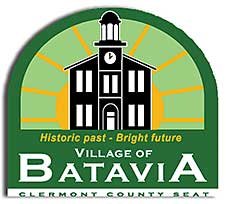Batavia may have had its young folks under control in the middle of the 19th century, but the country as a whole was far from being at rest. The sound of shots at Fort Sumter on April 12, 1861, turned everything topsy-turvy.
The little village of Batavia sent 100 men to battle in this conflict on Lincoln’s first call of April 14. Many more were to follow later, and the home was scarce that was not affected by its impact.
Mr. John Fairman wrote an article in 1896 describing the old muster roll of the Civil War. At that time he stated:
“Some of the names were written in lead pencil, most of them in ink, but all were written in patriotism. The volunteers were secured under Lincoln’s first call for men on April 14, 1861. The meeting was held at the Court House. Just in front of the bar sat Julius A. Penn, the organizer of the Company, and a number of the older citizens of town. Many other people were in the Court House, a number of them ladies. The meeting had been assembled at the roll of the drum, and its object was stated by Mr. Penn after the people had taken their seats. The call was for volunteers to suppress treason, and the term of service was for three months. Here were paper, pens, and ink. The date was April 17, 1861. As each patriot signed his name, three cheers were given, accompanied by the stirring roll of the drum.
“The boys, the oldest was barely 22, made a dashing appearance as they paraded and drilled daily on the Main Street to the notes of Charlie Craine’s fife and the rub-a-dub of the drum as performed upon by John Robinson, the druggist.
“At length, orders were received to report to Camp Chase, Columbus. The Company was paraded in front of the Court House, and as handsome a troop of stalwart young men it was as one might wish to see. Men were in line from all occupations — blacksmiths, clerks, bookkeepers, printers, editors, lawyers, tanners, tinners, wheelwrights, students — everybody, in short.
“Drawn up in a line in front of the Davis House (later the Clermont Hotel, now Haglage Park) were wagons decorated with flags and horses decorated with plumes; banners and bunting were visible everywhere. Music filled the air. The ladies passed along the line and gave flowers and tears and golden tokens to the bright young men who stood so proudly in their places with rosy cheeks and bright eyes, the last sometimes dimmed by the tears that would come, when the words of good-bye were spoken or a gentle pressure of the hand that drew from the soul what words might not. And so they marched away to the merry sound of the trumpets and all the rest is known.”
For a glimpse of our village during this conflict, nothing would be more dramatic than the account which is to follow, written by James B. Swing in 1916. This following article appears through the courtesy of Mrs. Jean Hughey:
“Batavia, Clermont County, Ohio, was in Civil War days a sweet, old-fashioned village; no railroad, no telegraph; a little out of the way; but with much natural beauty and with intelligent, refined, superior people, full of patriotic spirit.
“The following sketch of childhood recollections of Civil War times in Old Batavia was written for the information of younger relatives of the writer, who he thinks ought to know something of the great old days in the history of a village that should be dear to them. The sketch is printed now in a little pamphlet, not for general distribution, but as a means of its preservation in the hands of those for whom it was written. An account of the life and spirit of any old-fashioned northern village in the days of the Civil War, better written than this, giving a more graphic picture, might be a chapter in the history of the time not wholly uninteresting to the general reader.
“The writer would like to make particular mention of every one of the old Batavia soldier boys, and may some time do that, They all have their honorable places, secure in the long line of the shining heroes of the history of our country and of the world.
“I remember the Civil War very well from its beginning. I was six years old, nearly seven, when it began. My mother died in April, 1861, the year and the month in which the war began. I dimly remember my father coming home from his office one day at noon and telling my mother in an anxious way, that impressed my child mind, that we were going to have war. That must have been only a few days before her death. I remember President Lincoln’s first call for troops, 75,000 men, to serve for three months. I remember the formation of a company of volunteers at Batavia, under that call. I remember their going away and their return. They went to West Virginia. After their return, I would stand on the street and listen when they would be talking of their experiences in West Virginia. I remember hearing some of them one day joking with Judge George W. Hulick, then a young lawyer who had been an officer of the company — Captain, I think — about some girls he had met in West Virginia.”
James Swing’s memoir continues next week. Excerpted from History of Batavia, Ohio, 1814–1965, by Rosanna Hoberg. Some references are edited to reflect 2014 circumstances.
Batavia is celebrating its bicentennial this year, and The Clermont Sun is publishing a series of historic vignettes. The late Rosanna Hoberg, author, was a columnist and reporter for The Clermont Sun. This column was written in 1964.

